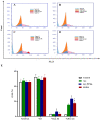Andrographolide nanophytosomes exhibit enhanced cellular delivery and pro-apoptotic activities in HepG2 liver cancer cells
- PMID: 36762548
- PMCID: PMC9930834
- DOI: 10.1080/10717544.2023.2174209
Andrographolide nanophytosomes exhibit enhanced cellular delivery and pro-apoptotic activities in HepG2 liver cancer cells
Abstract
Andrographolide (AG), a major active constituent of Andrographis paniculata, is known to hinder proliferation of several types of cancer cells. However, its poor solubility and cellular permeability restrict its use in clinical applications. In this study, AG-loaded phytosomes (AG-PTMs) were formulated and optimized with respect to particle size using l-α-phosphatidylcholine (PC):AG ratio and sonication time (ST) as independent variables. The optimized formula was prepared at 1:2.7 for AG:PC molar ratio and 4.9 min for ST and exhibited a particle size of 243.7 ± 7.3 nm, polydispersity index (PDI) of 0.310 and entrapment efficiency of 72.20 ± 4.53. Also, the prepared formula showed a slow release of AG over 24-h period. The antiproliferative activity of AG-PTMs was investigated against the liver cancer cell line HepG2. AG-PTMs significantly repressed the growth of HepG2 cells with an IC50 value of 4.02 ± 0.14 µM. AG uptake by HepG2 cells was significantly enhanced in incubations containing the optimized formula. AG-PTMs also caused G2-M cell cycle phase arrest and increased the fraction of apoptotic cells in pre-G1 phase. These effects were associated with induction of oxidative stress and mitochondrial dysfunction. In addition, AG-PTMs significantly upregulated mRNA expression of BAX and downregulated that of BCL2. Furthermore, AG-PTMs significantly enhanced the concentration of caspase-3 in comparison to raw AG. These data indicate that the phytosomal delivery of AG significantly inhibited HepG2 cell proliferation through enhanced cellular uptake, arresting cell cycle at the G2-M phase and inducing mitochondrial-dependent apoptosis.
Keywords: Andrographolide; HepG2 cells; apoptosis; liver cancer; phytosomes.
Conflict of interest statement
The authors declare no conflict of interest.
Figures










Similar articles
-
Andrographolide induces cell cycle arrest at G2/M phase and cell death in HepG2 cells via alteration of reactive oxygen species.Eur J Pharmacol. 2007 Jul 30;568(1-3):31-44. doi: 10.1016/j.ejphar.2007.04.027. Epub 2007 Apr 22. Eur J Pharmacol. 2007. PMID: 17512926
-
Inhibition of hepatocellular carcinoma cell proliferation through regulation of the Cell Cycle, AGE-RAGE, and Leptin signaling pathways by a compound formulation comprised of andrographolide, wogonin, and oroxylin A derived from Andrographis Paniculata(Burm.f.) Nees.J Ethnopharmacol. 2024 Jul 15;329:118001. doi: 10.1016/j.jep.2024.118001. Epub 2024 Mar 11. J Ethnopharmacol. 2024. PMID: 38467318
-
The pro-apoptotic activity of sinueracasbanone D isolated from Sinularia Leptoclados in hepatocellular carcinoma cells.Environ Sci Pollut Res Int. 2023 Apr;30(19):56920-56929. doi: 10.1007/s11356-023-26466-8. Epub 2023 Mar 17. Environ Sci Pollut Res Int. 2023. PMID: 36930304
-
Andrographis paniculata extracts and major constituent diterpenoids inhibit growth of intrahepatic cholangiocarcinoma cells by inducing cell cycle arrest and apoptosis.Planta Med. 2014 May;80(7):533-43. doi: 10.1055/s-0034-1368399. Epub 2014 Apr 29. Planta Med. 2014. PMID: 24782229
-
Inhibition of cancer cell growth by oleanolic acid in multidrug resistant liver carcinoma is mediated via suppression of cancer cell migration and invasion, mitochondrial apoptosis, G2/M cell cycle arrest and deactivation of JNK/p38 signalling pathway.J BUON. 2019 Sep-Oct;24(5):1964-1969. J BUON. 2019. PMID: 31786862
Cited by
-
Effects of Andrographolide-Loaded Nanostructured Lipid Carriers on Growth, Feed Efficiency, and Resistance to Streptococcus agalactiae in Nile Tilapia (Oreochromis niloticus).Animals (Basel). 2025 Jul 17;15(14):2117. doi: 10.3390/ani15142117. Animals (Basel). 2025. PMID: 40723582 Free PMC article.
-
Targeting signaling pathways with andrographolide in cancer therapy (Review).Mol Clin Oncol. 2024 Sep 5;21(5):81. doi: 10.3892/mco.2024.2779. eCollection 2024 Nov. Mol Clin Oncol. 2024. PMID: 39301125 Free PMC article. Review.
-
Inflammation, Mitochondria and Natural Compounds Together in the Circle of Trust.Int J Mol Sci. 2023 Mar 24;24(7):6106. doi: 10.3390/ijms24076106. Int J Mol Sci. 2023. PMID: 37047080 Free PMC article. Review.
-
New pyrazolylindolin-2-one based coumarin derivatives as anti-melanoma agents: design, synthesis, dual BRAFV600E/VEGFR-2 inhibition, and computational studies.RSC Adv. 2024 Feb 16;14(9):5907-5925. doi: 10.1039/d4ra00157e. eCollection 2024 Feb 14. RSC Adv. 2024. PMID: 38370458 Free PMC article.
-
Polyphyllin I attenuates the invasion and metastasis via downregulating GRP78 in drug-resistant hepatocellular carcinoma cells.Aging (Albany NY). 2023 Nov 6;15(21):12251-12263. doi: 10.18632/aging.205176. Epub 2023 Nov 6. Aging (Albany NY). 2023. PMID: 37934581 Free PMC article.
References
-
- Akowuah GA, Zhari I, Norhayati I, Mariam A. (2006). HPLC and HPTLC densitometric determination of andrographolides and antioxidant potential of Andrographis paniculata. J Food Compos Anal 19:118–26.
-
- Aldawsari HM, Badr-Eldin SM. (2020). Enhanced pharmacokinetic performance of dapoxetine hydrochloride via the formulation of instantly-dissolving buccal films with acidic pH modifier and hydrophilic cyclodextrin: factorial analysis, in vitro and in vivo assessment. J Adv Res 24:281–90. - PMC - PubMed
MeSH terms
Substances
LinkOut - more resources
Full Text Sources
Medical
Research Materials
Miscellaneous
